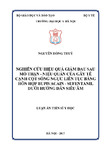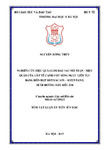
Vui lòng dùng định danh này để trích dẫn hoặc liên kết đến tài liệu này:
http://dulieuso.hmu.edu.vn/handle/hmu/1665| Nhan đề: | Nghiên cứu hiệu quả giảm đau sau mổ thận - niệu quản của gây tê cạnh cột sống ngực liên tục bằng hỗn hợp bupivacain - sufentanil dưới hướng dẫn siêu âm |
| Tác giả: | Nguyễn Hồng, Thủy |
| Người hướng dẫn: | PGS.TS. Nguyễn Quốc, Anh GS.TS. Nguyễn Quốc, Kính |
| Từ khoá: | 62720121;Gây mê hồi sức |
| Năm xuất bản: | 2017 |
| Tóm tắt: | . THÔNG TIN TÓM TẮT NHỮNG KẾT LUẬN MỚI CỦA LUẬN ÁN TIẾN SĨ. Tên đề tài: “Nghiên cứu hiệu quả giảm đau sau mổ thận - niệu quản của gây tê cạnh cột sống ngực liên tục bằng hỗn hợp bupivacain - sufentanil dưới hướng dẫn siêu âm”.. Chuyên ngành: Gây mê Hồi sức Mã số: 62720121. Nghiên cứu sinh: Nguyễn Hồng Thủy. Người hướng dẫn: 1. PGS.TS. Nguyễn Quốc Anh 2. GS.TS. Nguyễn Quốc Kính. Cơ sở đào tạo: Trường Đại học Y Hà Nội. Những kết luận mới của luận án:. 1. Hiệu quả giảm đau sau mổ qua catheter cạnh cột sống ngực dưới hướng dẫn siêu âm tốt hơn kỹ thuật mất sức cản thể hiện qua: Độ lan tỏa của thuốc tê lên cảm giác (từ giờ thứ 4 đến giờ 48 sau mổ) nhiều hơn nhóm mất sức cản (7,28 ± 1,05 đốt sv 6,62 ± 1,15 đốt, p<0,05). Tỷ lệ chọc thành công ngay lần chọc kim đầu tiên của nhóm dưới hướng dẫn siêu âm cao hơn nhóm mất sức cản (93,3% sv 60%, p < 0,05) và số lần chọc kim thấp hơn (1,05 ± 0,25 lần sv 1,49 ± 0,69 lần; p<0,05).. 2. Hiệu quả giảm đau của nhóm siêu âm được tiêm thuốc tê trước mổ qua catheter cạnh cột sống ngực tốt hơn nhóm siêu âm tiêm sau mổ thể hiện qua: Liều thuốc fentanyl trong gây mê ở nhóm siêu âm tiêm trước mổ thấp hơn nhóm tiêm sau mổ (237,77 ± 42,84 µg sv 352,22 ± 67,38 µg, p<0,05), thời gian yêu cầu giảm đau đầu tiên kéo dài hơn (74,68 ± 19,17 phút sv 28,17 ± 5,18 phút, p<0,05), thời gian tỉnh và thời gian rút nội khí quản nhanh hơn (13,62 ± 3,80 phút sv 17,84 ± 3,46 phút và 21,57 ± 4,96 phút sv 27,80 ± 4,98 phút, p<0,05); điểm đau VAStĩnh và VASđộng thấp hơn ở các thời điểm nghiên cứu trong 8 giờ đầu sau mổ; lượng bupivacain tiêu thụ trong ngày đầu, ngày thứ hai và cả hai ngày sau mổ ở nhóm siêu âm tiêm trước mổ thấp hơn nhóm siêu âm tiêm sau mổ (384,13 ± 29,22 mg sv 430,7 ± 34,35 mg, p<0,05). Mức độ rất hài lòng về phương pháp giảm đau cao hơn (48,8% sv 33,3%, p<0,05).. 3. Tác dụng không mong muốn của các kỹ thuật giảm đau cạnh cột sống ngực thấp: sự tăng nhịp tim và huyết áp động mạch sau khi rạch da của nhóm giảm đau cạnh cột sống ngực dưới hướng dẫn siêu âm tiêm trước mổ ít hơn nhóm siêu âm tiêm sau mổ và nhóm mất sức cản. Nhịp tim, huyết áp động mạch, nhịp thở và bão hòa oxy mao mạch ở ba nhóm ổn định và tương đương nhau tại các thời điểm nghiên cứu trong 48 giờ sau mổ. Tỷ lệ chọc vào mạch máu, đau tại vị trí gây tê, tụ máu dưới da, tụt huyết áp, buồn nôn - nôn, bí đái, run, ngứa và chưa trung tiện trong 48 giờ sau mổ chung của 3 nhóm tương ứng là: 5,1%, 2,9%, 0,7%, 3,7%, 14,8%, 5,3%, 1,5%, 5,2% và 54%, và không có sự khác nhau giữa các nhóm siêu âm với nhóm mất sức cản. Gặp 01 bệnh nhân bị thủng màng phổi ở nhóm mất sức cản nhưng không gây tràn khí màng phổi. Không gặp các tai biến như tràn khí màng phổi, tê tủy sống toàn bộ và ngộ độc thuốc tê trong nghiên cứu này.. NGƯỜI HƯỚNG DẪN PGS.TS. Nguyễn Quốc Anh NGHIÊN CỨU SINH Nguyễn Hồng Thủy . ABSTRACT OF NEW CONCLUSIONS OF THE THESIS. The fulle title of the Thesis: “Study the analgesic efficacy after kidney-ureter surgery of continuous thoracic paravertebral block ultrasound-guided infusions of a mixture bupivacaine - sufentanil”.. Speciality: Anesthesiology Code: 62.72.01.22. Candidate’s name: Nguyen Hong Thuy. Sciencific supervisors: 1. Assistant Professor, Ph.D. Nguyen Quoc Anh 2. Professor, Ph.D. Nguyen Quoc Kinh. Name of training University: Hanoi Medical University. New conclusion of the Thesis:. 1. The analgesic efficacy of the insertion of the thoracic paravertebral catheter ultrasound - guided was better than loss of resistance technique:. The spread of the spread of sensory segments blockake on the skin of group ultrasound guidance was higher than lost resistance group (from 4 hours to 48 hours postoperative) (7,28±1,05 segments sv 6,62±1,15 segments, p<0,05). The rate of successful first attempt of ultrasound guidance group was significant higher than loss of resistance group with p<0,05 (93,3% sv 60%) and the number of attempt in ultrasound guidance group were significant lower than loss of resistance group with p<0,05 (1,05±0,25 attempts sv 1,49 ±0,69 attempts).. 2. The analgesic efficacy of ultrasound preoperative injection group by thoracic paravertebral catheter was better ultrasound postoperative injection group: The dose of fentanyl of ultrasound preoperative injection group was significant lower than ultrasound postoperative injection group with p<0,05 (237,77 ± 42,84 µg sv 352,22 ± 67,38 µg). Time required first analgesic of preoperative injection group ultrasound prolonged significantly than postoperative injection ultrasound group with p <0,05 (74,68 ± 19,17 minutes sv 28,17 ± 5,18 minutes). Time to recovered consiousness and time to tracheal extubation of ultrasound preoperative injection group were shorter than ultrasound postoperative injection group, p<0,05. VASstatic scores and VASdynamic scores of preoperative injection group was always significant lower than postoperative injection group at the time points in the first 8 hours postoperative with p<0,05. The amount of bupivacaine of preoperative injection group was significant lower than postoperative injection group in the first day, in the second day and in the two day after surgery with p<0,05. The excellent satisfaction of ultrasound preoperative injection group was higher than ultrasound postoperative injection group, p<0,05 (48,8% sv 33,3%).. 3. The side effects of techniques thoracic paravertebral analgesia were low: The increase heart rate and mean arterial pressure after incision of ultrasound preoperative injection group was lower than ultrasound postoperative injection group and lost of resistance group with p<0,05. The heart rate, mean arterial pressure, respiratory rate and oxygen saturation were stable and similar between 3 groups at the time points in 48 hours after surgery with p>0,05. The rate of vascular puncture, pain at the site anesthesia, subcutaneous hematoma, hypotension, nausea - vomiting, urinary retention, tremors, itching and no flatus during 48 hours after surgery: 5,1%, 2,9%, 0,7%, 3,7%, 14,8%, 5,3%, 1,5%, 5,2% and 54%, there was no statistical difference between the two groups ultrasound-guided and the loss of resistance group, p>0,05. We met 01 patients of pleural puncture in the loss of resistance group without not causing pneumothorax. We met not complications such as pneumothorax, total spinal anaesthesia and anesthetic toxicity this study SCIENCIFIC SUPERVISORS Assistant Professor, Ph.D. Nguyen Quoc Anh CANDIDATE Nguyen Hong Thuy . |
| Định danh: | http://dulieuso.hmu.edu.vn//handle/hmu/1665 |
| Bộ sưu tập: | Luận án (nghiên cứu sinh) |
Các tập tin trong tài liệu này:
| Tập tin | Mô tả | Kích thước | Định dạng | |
|---|---|---|---|---|
| 226_NGUYEN HONG THUY-LA.pdf Tập tin giới hạn truy cập | 3.11 MB | Adobe PDF |  Đăng nhập để xem toàn văn | |
| 226_NguyenHongThuy-tt.pdf Tập tin giới hạn truy cập | 1.95 MB | Adobe PDF |  Đăng nhập để xem toàn văn |
Khi sử dụng các tài liệu trong Thư viện số phải tuân thủ Luật bản quyền.